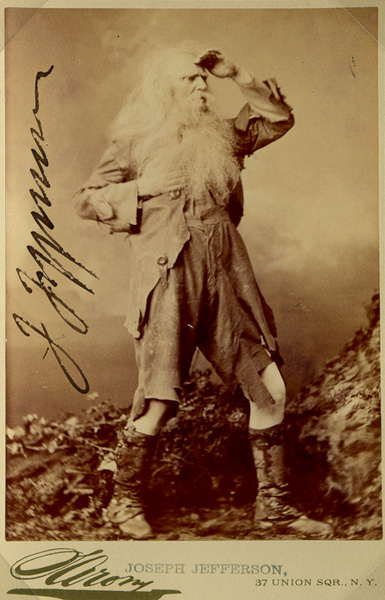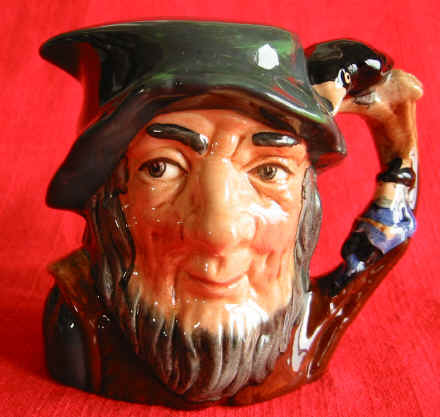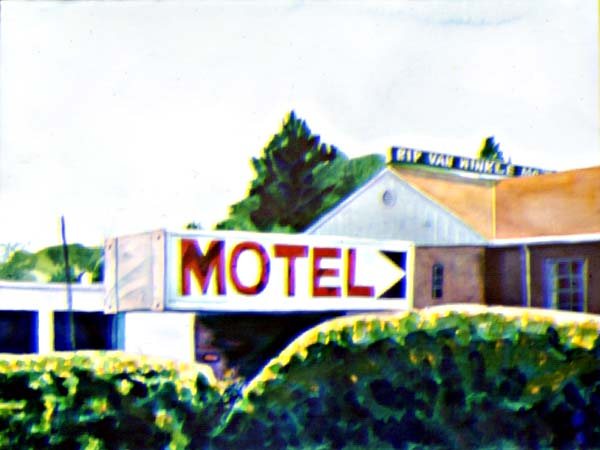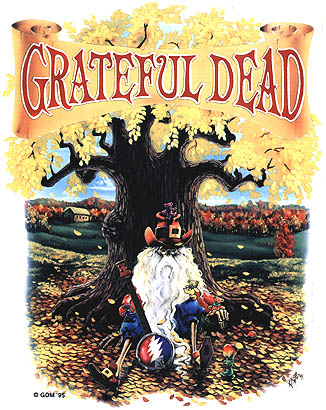
Lecture Notes
LITR 4232 American
Renaissance

Lecture Notes
Meeting 2: Washington Irving, “Rip Van Winkle” and “The Legend of Sleepy Hollow”

Tompkins H. Matteson (1813 - 1884)
Rip Van Winkle’s Return
Oil on canvas, 1860
("Hudson River School" of American Romantic painting in mid-19th
century)
Today's schedule
Presentation schedule
Mohicans assignments
Obj. 1: popular, classic, representative?
Romanticism & Gothic (obj. 2)
Thursday, 28 August: Washington Irving 951-985 (“Rip Van Winkle” and “The Legend of Sleepy Hollow”)
Text-Objective Discussion: Faron Samford
Tuesday, 2 September: conclude Irving, begin James Fenimore Cooper, The Last of the Mohicans, chapters 1-3 (pages 1-35 in Penguin Classics edition.)
Web highlight (Midterms on Irving / Cooper): instructor
Thursday, 4 September: Cooper, The Last of the Mohicans, through chapter 13 (thru p. 133 in Penguin edition.)
Text-Objective Discussion: Bryan McDonald
Mohicans assignments
Bring Irving stories and Mohicans next Tuesday, after that just Mohicans for next two weeks
Finish up Irving
Note "Ichabod" style character in Mohicans (David Gamut, psalmist)--Sleepy Hollow written 1820, Mohicans 1826
Why we're reading Last of the Mohicans
Pro:
Enduring classic with resonance in popular culture, significance to American identity, culture, etc.
International bestseller when published, never out of print
huge example of Romantic style applied to an American setting
interesting, surprising undercurrent on race relations, centered around figure of Cora
Con:
Novel is big, clunky, some shockingly good parts, some extensively dreary and talky
Cooper = "the worst great writer ever"--see Twain's "Literary Offences"
sometimes simply hard to read . . . but most readers find their way through it
Course
Objectives:
1. To use "close reading" and "Historicism" as ways of studying classic, popular, and representative literature and cultural history of the "American Renaissance" (the generation before the Civil War).
2. To study the movement of "Romanticism," the narrative genre of "romance," and the related styles of the "gothic" and "the sublime." (The American Renaissance is the major period of American Romantic Literature.)
3. To use literature as a basis for discussing representative problems and subjects of American culture (Historicism), such as equality (race, gender, class); modernization and tradition; the individual, family; and community; nature; the role of writers in an anti-intellectual society.
Assignments for Irving's
"Rip Van Winkle" & "Legend of Sleepy Hollow"
Objective 1. To use critical techniques
of "close reading" and
"New
Historicism" as ways of studying classic,
popular, and representative literature and cultural history of the "American
Renaissance" (the generation before the Civil War).
Objective 1 applied to Irving: classical and popular literature:
In what ways are these "classic" texts?
In what ways are they "popular?"
About their "popularity," why do people know these texts, even if they haven't read them? How do they keep a special place in the minds of Americans?
(Compare Robinson Crusoe, Romeo & Juliet)
***
Objective 2. To study the movement of "Romanticism,"
the narrative genre of
"romance," and the related styles of the "gothic" and "the sublime."
Objective 2 applied to Irving: Romanticism and the
Gothic
How does the Gothic appear in "Rip Van Winkle" & "Legend
of Sleepy Hollow?"
What is the gothic's significance to Romanticism?
Introduction to the Gothic
****
Objective 3. To use literature as a basis
for discussing representative problems and subjects of American culture (New
Historicism), such as equality; race, gender, class; modernization and
tradition; the family; the individual and the community; nature; the writer's
conflicted presence in an anti-intellectual society.
Objective 3: typical issues, problems, or
themes in American literature and culture: "modernity" or
"modernization" vs. tradition
"change" vs. "traditional values"
"Modernization" is the ongoing revolution in
values and material life that began in Ancient Greece and was reborn in modern
Europe with the Renaissance approximately 500 years ago. Modernization is a
sociological concept involving
many aspects of human and natural life:
human equality (in opportunity or possibility if not in fact)
secularization
urbanization (farms > city)
rise of middle class
nationalism (i. e., identification of a person as "an American" rather
than a member of a tribe, family, or state)
authority of tradition is replaced by authority of empirical science and
observable human behavior
pace of change constantly accelerates, with occasional pauses (e. g., the 1950s)
lifespans lengthen; population increases
in most material terms, modern life offers a better standard of living than the past did
reactions against modernization include fundamentalism, "family values,"
nostalgia for earlier times
Standard contrast with "modern" is "traditional"--modernity threatens tradition; it disrupts and unsettles older ways of life
Modernity and change are confusing, disorienting--desire for simplicity of past (which wasn't really simple, just familiar)
> popularity of occult or supernatural + conspiracy during rapid change: people want to understand in familiar, personal terms
"Modernization" is relevant to study of the American
Renaissance because
The American Renaissance is the period when Americans first began moving to
cities in large numbers and experiencing the other changes listed above on a
large scale.
Some literature of the period shows changes of intellect,
lifestyle, and nature that resulted and how people adjusted. (Literature as
engagement)
Much "Romantic" literature (such as "The Legend of Sleepy
Hollow" and The Last of the Mohicans or The Scarlet Letter) is set in an earlier or more
rural time and place.
Assignments for Irving's
"Rip Van Winkle" & "Legend of Sleepy Hollow"
Objective 1. To use critical techniques
of "close reading" and
"New
Historicism" as ways of studying classic,
popular, and representative literature and cultural history of the "American
Renaissance" (the generation before the Civil War).
Objective 1 applied to Irving: classical and popular literature:
In what ways are these "classic" texts?
In what ways are they "popular?"
About their "popularity," why do people know these texts, even if they haven't read them? How do they keep a special place in the minds of Americans?
1. To use critical techniques of "close reading" and "New Historicism" as ways of studying classic, popular, and representative literature and cultural history of the "American Renaissance" (the generation before the Civil War).
In what ways are Irving's stories popular, classic, and / or representative?
Link
to sample student essay on popular, classic, and representative literature
Popular
&
classic
literature
terms
can overlap without negating each other (e. g., Douglass both representative and
classic)
Popular Classic Authors:
Twain
Shakespeare
Dickens
Irving
Cooper
Poe
(harder to find later)
Frost?
Langston Hughes
Toni Morrison
How is Irving "popular"?
descriptions
+ picturesque, abundance
How
like a sitcom?
Sentiment
Stock / stereotype characters
Humor / comedy
nostalgia
How classical?
Insight, criticisms
Historical comprehensions
Compositional
integrity (not just a lot going on, but parts fit)
Not
representative
2105
musician an old gray-headed negro
pyramid
of shining black faces
2106
grinning rows of ivory from ear to ear
2107
what passed at this interview I will not pretend to say
2108
O these women! These women!
How
is Irving popular?
appeals to everyone more or less; or even if it doesn’t appeal, it’s not threatening to anyone except overly intellectual or prissy sorts
Sentiment: childhood, dog, scenes of abundance, nostalgia
descriptions + picturesque, abundance
picturesque--sleepy abundance of autumn
(picturesque: 1. Resembling a picture; suggesting a painted scene. 1b. charming, quaint)
perpetual club of the sages, small inn, George III, endless sleepy stories about nothing
whole group reminded Rip of the figures in an old Flemish painting
abundance
bursting forth with the treasures of the farm
vast store of apples, great fields of Indian corn
How like a sitcom?
Restoration of family, social order; rejection of outsider (Ichabod)
Rip’s daughter took him home
Sentiment
Pushes easy emotional buttons; Spielberg movies, family movies
children, dogs
Stock / stereotype characters
stock characters
termagant wife
lazy husband, lovable ne'er do well (Kramer?)
“naturally a thirsty soul”
prissy schoolmaster
irritated jock: burly, roaring, roistering blade
rich babe
simple,
familiar plot
path crossed by . . . a woman
Humor / comedy
Ichabod’s head, body
loud voice
superstitious, odd mixture of small shrewdness and simple credulity
dog sings along
Gunpowder
Ichabod’s body
just time to save himself by clasping old Gunpowder round the neck
nostalgia
a village of great antiquity
many years since [but not really]
they are given to all kinds of marvelous beliefs (premodern)
How classic?
Style:
Compositional
integrity (not just a lot going on, but parts fit)
Subtlety
rather than obviousness
But
remains popular b/c
technique doesn’t declare itself (sleep / ghost)
shift to dream?
Not obvious, not reductive, not “the same old same old”
Most popular culture simply reinforces ideas, attitudes we already have
Classic literature rich with meaning, keeps giving off meaning, not obvious
Contains important ideas, comprehension of historical change
inn > hotel
tree > flagpole
very character of the people seemed changed
riot in the village?
RVW experience of every generation
Relate to objective 3: American Renaissance as modernity and resistance
[Summary: Enlightenment vision of world of laws, in which nature and culture are unchanging, or always progressing, gives way to a world of change and decay. Romanticism as nostalgia.]
village was altered: larger and more populous
house gone to decay
called loudly . . . lonely chambers rang
(Legend) fixed x great torrent of migration and improvement . . . changes
(Legend) > Kentucky
(Van
Winkle) shifting throng > ghosts . . . in long established Dutch
communities
2. To study the movement of "Romanticism," the narrative genre of "romance," and the related styles of the "gothic" and "the sublime."
Romanticism
(obj. 2)
Historical,
trans-cultural, international movement, value system in literature and arts,
response to massive social changes in Europe and USA
Still
very influential in popular attitudes: love of nature, past, children,
innocence, etc.
Movement itself: late 18th > 19th century (late 1700s > 1800s)
Spreads out into popular culture
Romantic music (Beethoven, Chopin, Schubert, Tchaikovsky)
Romantic painting (Millais, Turner > Impressionism)
Romantic Literature
Germany: Goethe, Schilling, Heine
England: Wordsworth, Coleridge, Blake, Byron, Shelley, Keats
concept more or less alive in popular culture
“how romantic”—affectionate eroticism + exotic / faraway / quaint
e. g., cuddling in front of a fire in a ski lodge in the Swiss Alps
honeymoon on a tropical island
broader usage
—values and aesthetic system—started in early 19c, continues today—nature, childhood, past good—cities, adulthood, present bad
the world has spirit
The Indians considered them the abode of spirits . . . ruled by an old squaw spirit . . . . kind of Manitou or Spirit, who kept about the wildest recesses of the Catskill Mountains
Hudson . . . crown of glory
sublime
down into a deep mountain glen, wild, lonely, and shagged; the bottom filled
with fragments from the impending cliffs
something strange and incomprehensible about the unknown, that inspired awe and
checked familiarity
gothic—
decaying mansion
light / dark plus red
mansion
> nature
haunted by strange beings
[haunted castle] > haunted valley
so seldom hear of ghosts, except in our established Dutch communities
great tree, woman in white that haunted the dark glen
whitewashed walls shine modestly
large brook among broken rocks and trunks of fallen trees
enormous tulip tree, gnarled, fantastic
groan – rubbing of one huge bough upon another
huge misshapen, black, and towering
haunted fields, brooks, bridges
romance
pop cultural uses: Harlequin romance, American Romance classics
true
love, happily ever after, ends on a kiss
academic uses:
—a kind of story or narrative—“quest,” rescue, transcendence (happily ever after)—fairy tales, Arthurian tales of nights in shining armor, long ago and far away
ex. Star Wars, Officer and Gentleman, Dances with Wolves
romantic
comedy: Sleepless in Seattle, When Harry Met Sally
knight-errant of yore, fiery dragons and such like, castle-keep, lady of his
heart
knight-errant in quest of adventures . . . in the true spirit of romantic story
correspondence
every sound of nature, at that witching hour, fluttered his excited imagination
sank deep in the mind of Ichabod
all the stories of ghosts and goblins . . . came crowding upon his recollection.
The night grew darker and darker
Visual Arts concerning Rip Van Winkle
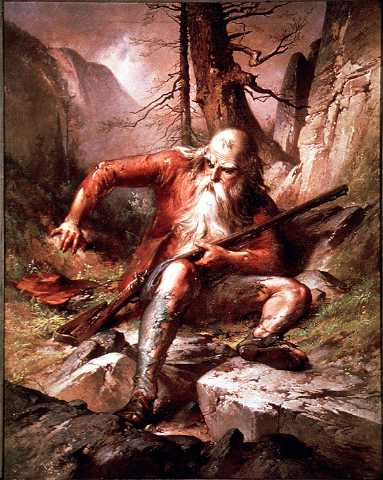
George Frederick Bensell (1837-1879)
Rip Van Winkle
Oil on canvas
